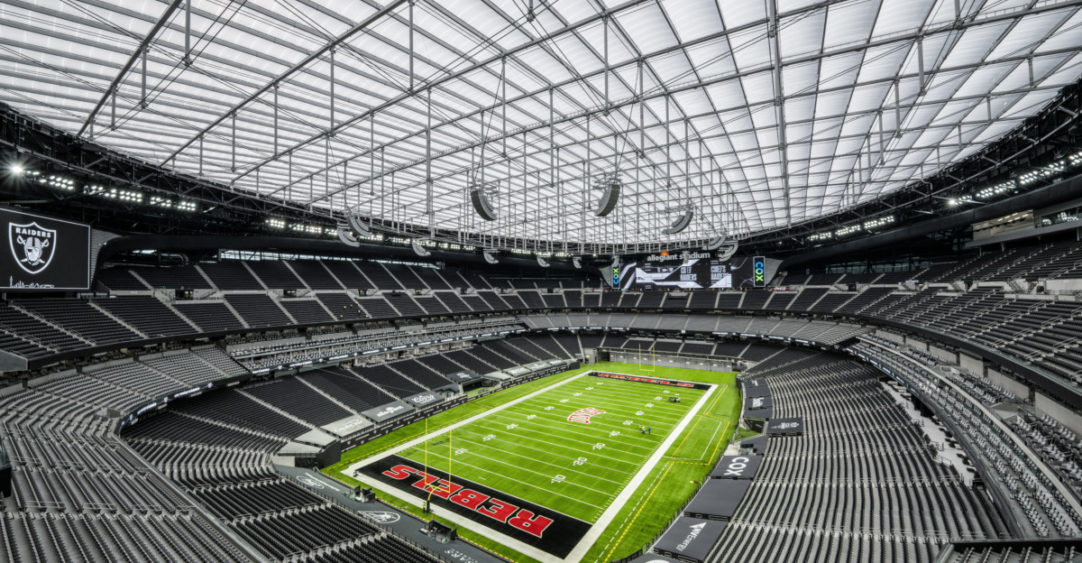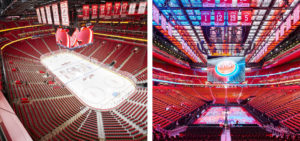
Top 5 List of Design Considerations for an Owner
SSR has been providing engineering and consulting services to the sports and entertainment market for nearly three decades. Throughout that time, we’ve been privileged to work with dozens of owners with various degrees of experience with a major construction project. From these experiences, we’ve compiled our TOP 5 List of Design Considerations for an owner as we begin design and development of mechanical, electrical, plumbing, fire protection, and technology systems of a new venue.
After much internal debate and consideration, we found the following items to be real drivers to create successful experiences and positive outcomes for owners.
Here is the SSR TOP 5 List countdown.
#5 – Operations and Events Schedule
#4 – Redundancy and Reliability Requirements
#3 – Sustainability Goals
#2 – Project Delivery Method
And #1 – Construction Budget and Cost Model
#5 – Operations and Event Schedule
As we begin to consider design options for building systems, it is imperative that we have a clear understanding of how the venue will be operated.
- How many events will be hosted each year?
- What type of events will be hosted?
- When does season begin and end for the home team?
- What does a typical non-event day or off-season schedule look like?
Accurate and thoughtful answers to the questions impact not only the design, but also the operation of MEP and technology systems for each venue. For example, if the venue is only planning to host 20 to 30 events per year, then partial load operation and efficiencies become much more important than full load efficiencies. However, if the goal is 200+ events per year, then full load efficiencies become the focus along with the ability to quickly turn over the venue for different event types. Then, casinos operate on a 24/7/365 schedule, which means that systems must be designed for zero down time. Owners should provide a projected events plan and schedule for each new venue. The events plan should include the event types to be hosted (home games, concerts, ice events, monster trucks, etc.) with special events like Super Bowl, Final Four, or maybe national political conventions, along with the projected quantity of each event.

Little Caesars Arena (Detroit, MI) is a multi-purpose arena that is home to the NBA’s Detroit Pistons and NHL’s Detroit Red Wings. Additionally, it hosts dozens of other events annually, including NCAA tournament games. concerts, and UFC and WWE events.
Based on our experience, we would recommend that owners on-board future operational staff as soon as possible, preferably during design. Don’t wait until the building is opening or about to open. Operations staff add real value to the design of building systems.
- During non-event periods, how will the venue be staffed?
- During the off season, will certain portions of the venue be shut down completely (as an example, plumbing systems drained down)?
As you can see, the answers to these questions inform the design of building systems, specifically in the case above plumbing design. In addition, training of the venue operations staff begins much earlier. They can learn about the systems during the design phase and see the systems through construction.
#4 – Redundancy and Reliability Requirements
How important is reliability and uptime to each owner? Through our experience in design of sports and entertainment venues, SSR has come to understand that redundancy and reliability of MEP systems means different things to different owners. For an NFL stadium, it means the potential of multi-million-dollar league fines for loss of broadcast during a Super Bowl or Playoff game, not to mention the embarrassment for a venue or even an entire city. We all remember the loss of power and resulting temporary darkness at the Superdome in New Orleans in 2013 at Super Bowl XLVII. Anecdotally, we have learned from casino owners that a single slot machine can generate $650,000 of revenue per year. So, if the gaming floor is down for just a few hours, the lost revenue can quickly escalate to several hundreds of thousands of dollars. For a small arena or ballpark, it may mean losing thousands of dollars in food and beverages stored in coolers…or maybe losing the ice sheet prior to a game schedule for the next day.
The owner must provide a clear understanding of their intent to continue operation of the building for an event and/or for daily operations-based system failure scenarios. “Without this guidance, we tend to focus on the code requirements for emergency and standby power, along with the required fuel storage, but I think we fail to fully explore the best options for interconnection of backup power for a wider range of scenarios,” noted SSR Electrical Principal Lynn Dee Thomas. For example, paralleling a diesel generator for code required loads with a natural gas generator, then back-feeding the normal distribution with defined operational sequences (i.e. manual disconnecting of selected loads) would allow for much more flexibility in building use – particularly if the venue were to be used for other function such as an emergency shelter, than pre-selecting some loads and connecting through an optional standby auto-transfer switch.
If all of the design focus is on providing redundant utility connections fed from different utility substations without a complete examination of all of the single points of failure throughout the entire system, then the result can be wasted money. Discussion of these failure points should take place early with the owner to define system design to ensure the owner’s money is wisely allocated. “Early identification of the owner’s requirements for continued operation is a key to success,” stated SSR Principal Scott Terry. If we are informed early in design, building systems can include proper redundancy from day one, and with developing technologies, there are efficient options using battery storage, natural gas generators, or even fuel cells over traditional design methods reliant on redundant utility power or diesel generators. Having a clear focus on the event and fan experience can help us choose the best options to invest in for peace of mind.
#3 – Sustainability Goals
Whether the goal is to address global climate change or to maximize the wellness of venue occupants, sustainable design should begin at project inception. Over the years, SSR has found that the true sustainability is engrained in the overall fabric of systems design and operation and is not as successful when added or “tacked on” at later stages. If sustainability goals are established early, innovative high-performance projects are achievable with careful design and planning. “Documenting carbon reduction, wellness, energy performance, and green building certification requirements within an OPR (Owner’s Project Requirements) document creates a firm handshake between ownership and the project team in regard to the key sustainability drivers. These factors typically result in realization of sustainability targets with minimal budget impact and positive returns on investment,” Eric Sheffer, SSR Director of Sustainability. With this in mind, owners should focus early in the design process, and possibly even at the RFP stage, to clearly establish a mission and goal for sustainability related to their venue.
#2 – Project Delivery Method
Delivery of projects has continued to evolve over the years. The pendulum has swung from the design-bid-build world to fully design-build projects to all points in between over the years. Now, there are many hybrid forms of delivery including design-assist, design-assist-build, and IPD (integrated project delivery) models. All of these options can lead to a successful project delivery for owners seeking to realize their goal of a new or newly renovated sports or entertainment venue. However, based on our experience, owners are best served when the delivery method is defined early, even during the RFP process, and communicated to the design team. Understanding how a project will be procured and delivered allows for design consultants to focus their expertise and efforts, including development of documents and BIM models, to align with expectations at each project phase and milestone.
Changing delivery methods during design can lead to poor outcomes. For hybrid delivery methods, design-assist trade partners must be engaged early in the process. SSR recommends no later than 50% schematic design. If trade partners are on-boarded too late, it is our experience that they feel disenfranchised because of little to no impact to the project design and delivery. Many times, the design of MEP systems is already “fully baked” at 100% design development, for example. The trade partners do not fully buy-in creating an antagonistic relationship, where they treat the project more like a design-bid-build project. The end result is a painful process of change orders and cost issues for the owner…and design consultants…to deal with throughout construction. Owners should define the project delivery early and then stick with it to the end of construction.
#1 – Construction Budget and Cost Model
SSR understands and accepts the responsibility to design the MEP and technology systems to a specified construction budget. However, the owner must commit to establishing an accurate construction budget and cost model early in the project. For a successful outcome, SSR must be included as a stakeholder in establishing and reviewing the specified construction budget for MEP and technology systems for the project at each phase of design. Consultants cannot be called out for designing a “Cadillac” system on a “Chevy” budget, if we don’t have a clear understanding of the cost model before we begin design. The initial concept cost model must be accurate and must be based on current market conditions and construction expertise related to similar sports and entertainment venues. SSR recommends an experienced, preconstruction services provider be engaged as part of the design team at an early stage of the project. In fact, it would greatly benefit the owner and design team if the preconstruction services provider was a stakeholder in the process as well. Our experience is that the cost models and construction budgets have a greater level of accuracy if the estimator has a stake in the process.
As a stakeholder, SSR collaborates with the architectural team, preconstruction services provider, and the owners’ representatives to establish the initial concept cost model for all building systems and maintain the budget throughout each stage of design. The key to success is for the team to focus on an accurate budget early in the process. The always present, value engineering process should be part of the on-going design process, not limited to last minute cost adjustments to meet budget. Aluminum electrical feeders, in lieu of copper feeders….victaulic pipe couplings, in lieu of fully welded piping…PEX plumbing piping, in lieu of copper piping are all viable design solutions that should be discussed and addressed compared to the cost model for the project. SSR understands that it is unacceptable to get to the 100% construction documents or GMP phase only to find out that you have a bust in the MEP or technology systems budget.
At each design phase, the MEP systems cost model should be updated and refined by the preconstruction services estimation team and compared to the initial budget. We have found that a key to budget accuracy is communication of scope changes to the preconstruction estimators as design progresses. Our goal is having no scope or budget surprises at milestone cost estimates.
Active communication of scope changes throughout the design process and not waiting until official milestone estimates lead to successful outcomes.
That brings us to the end of the TOP 5 list presented to you by the SSR sports and entertainment group. We are excited to share our knowledge and experience related to the successful design, and ultimately the construction, of your next venue or major renovation of your existing venue. Our hope is that each TOP 5 item will inform and instill confidence in owners as they approach their next venture resulting in an exceptional experience, and ultimately for the fans and players.








